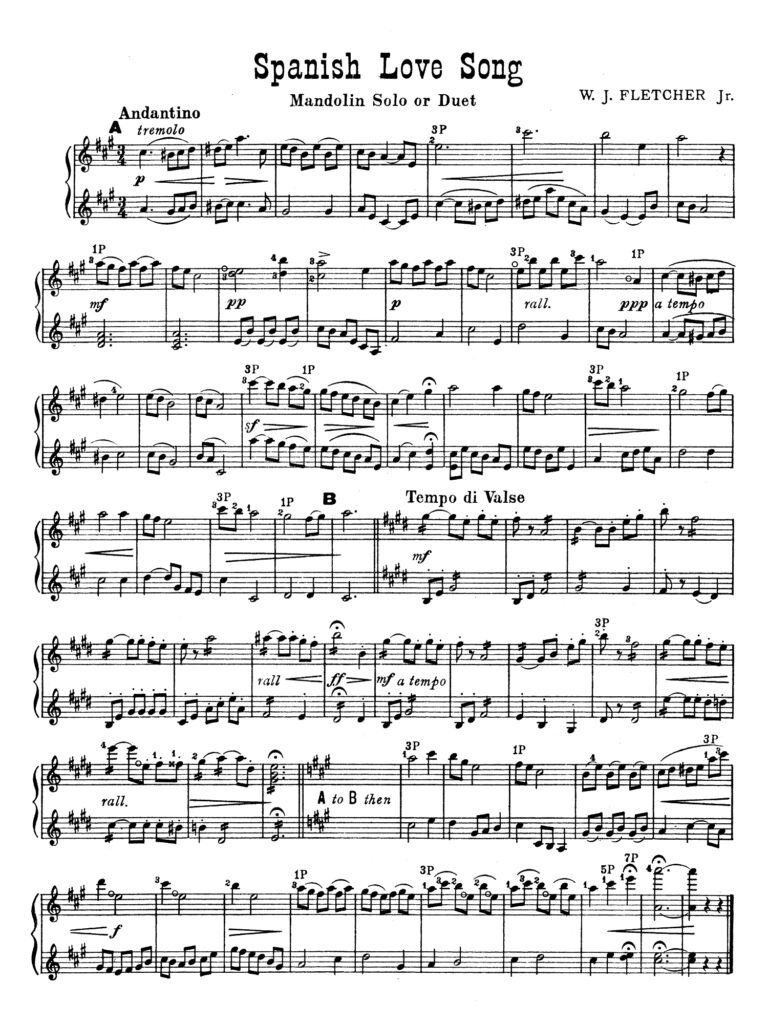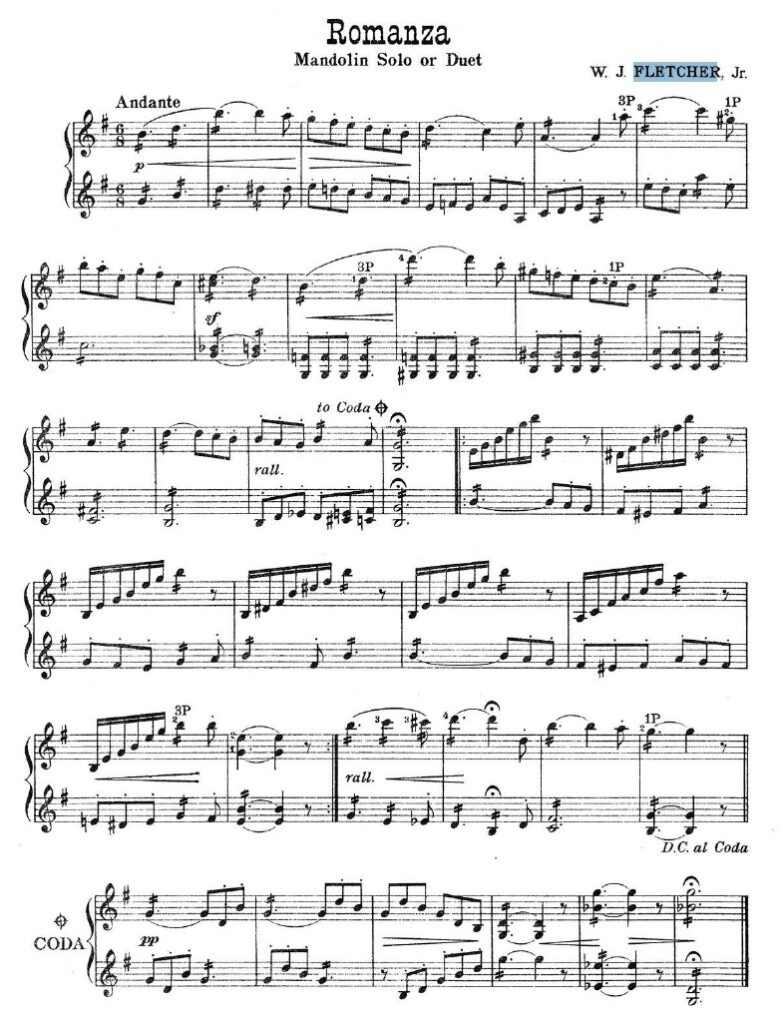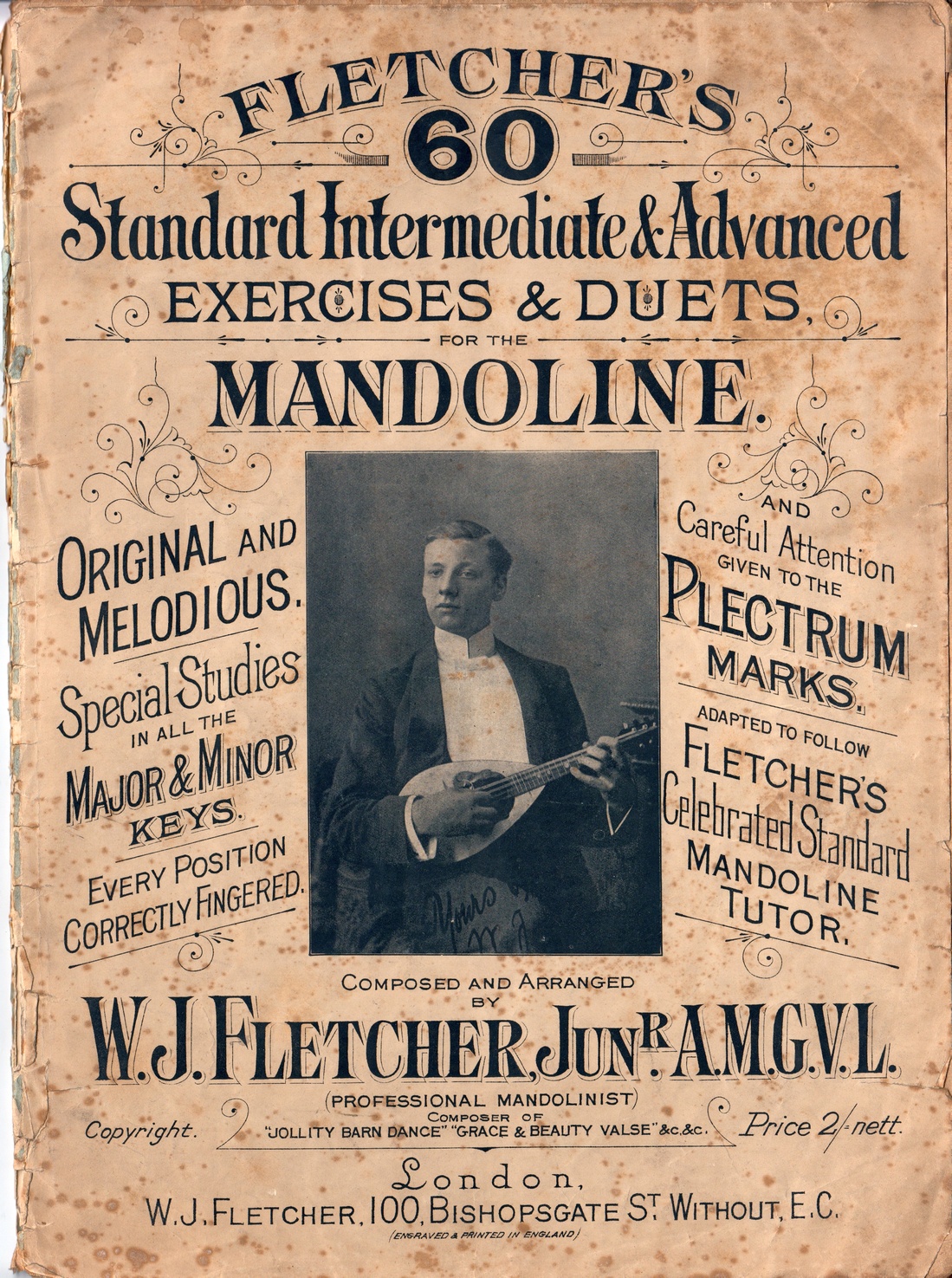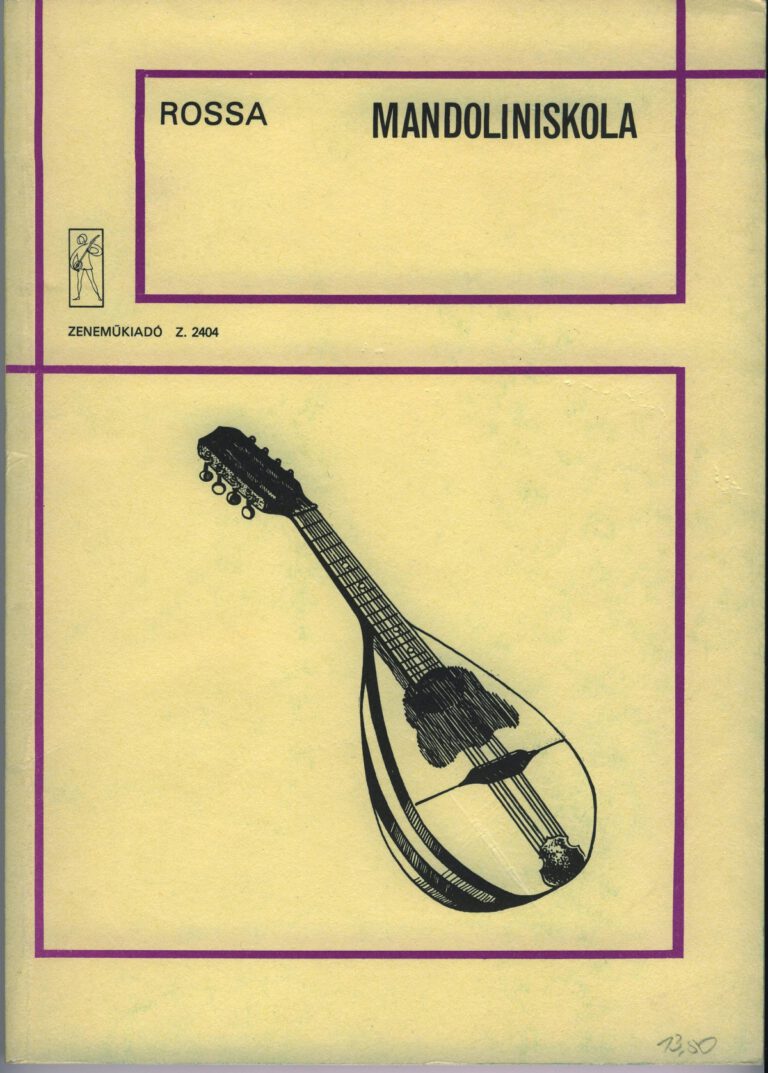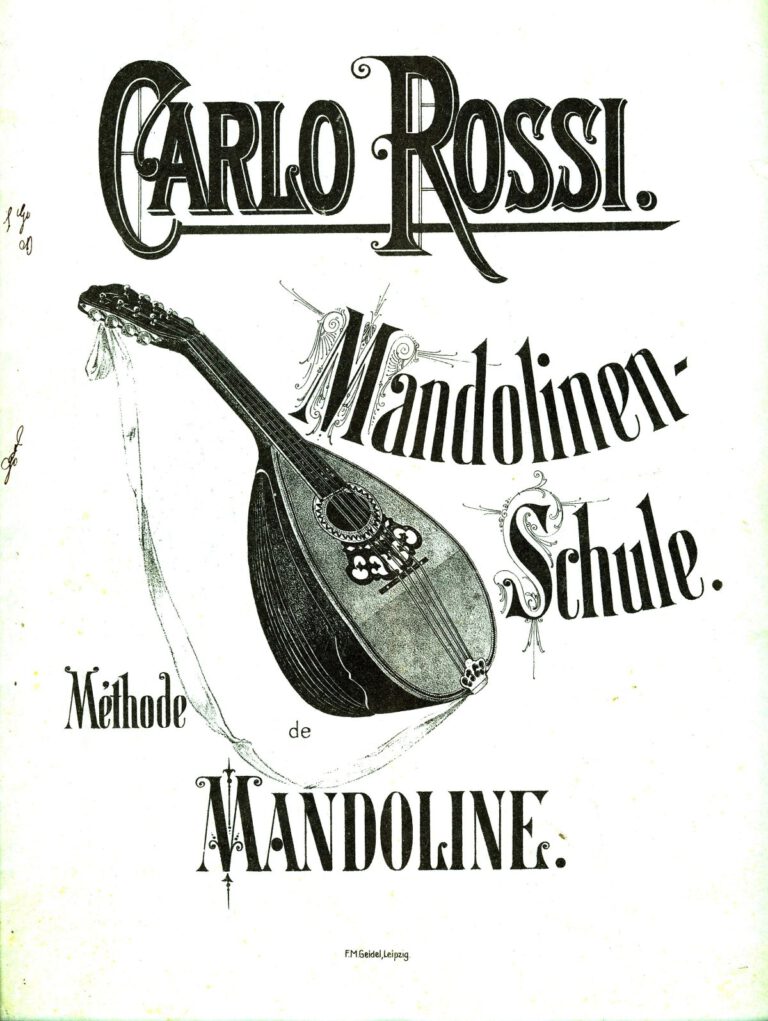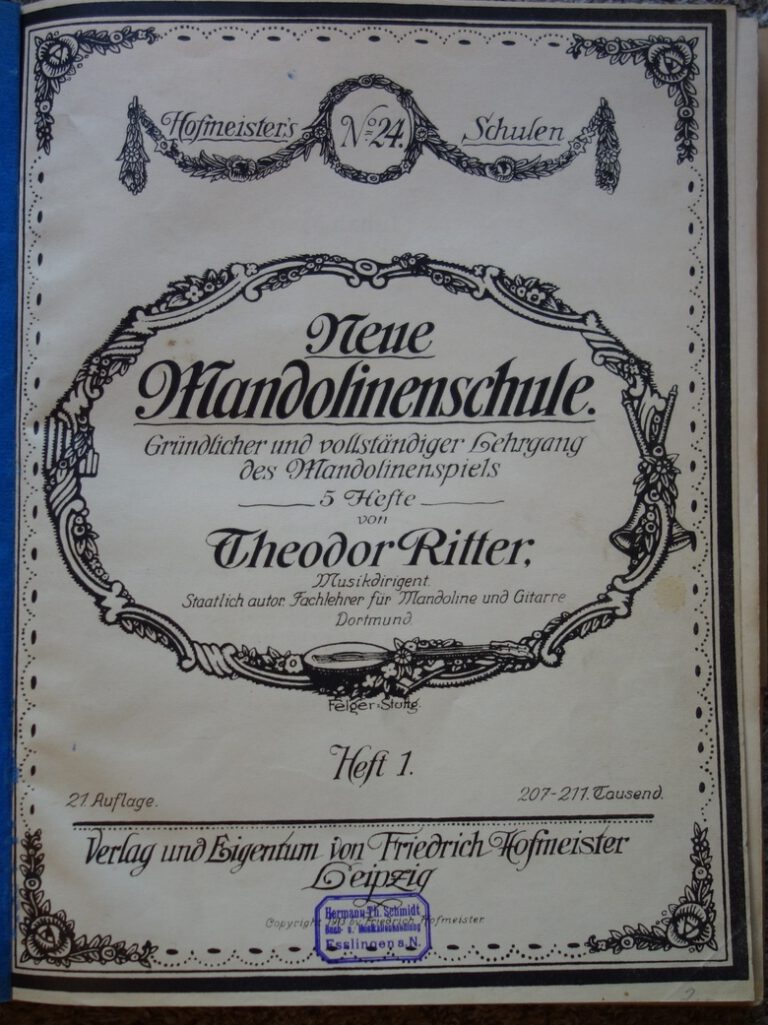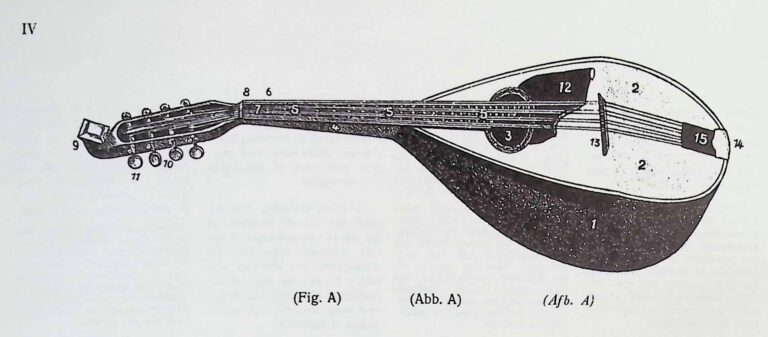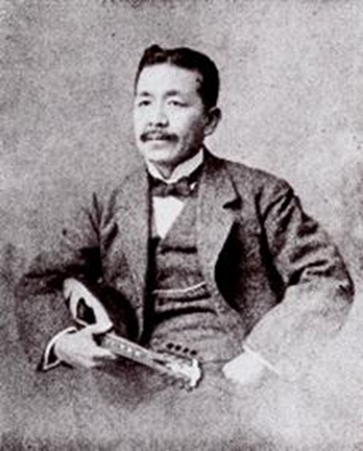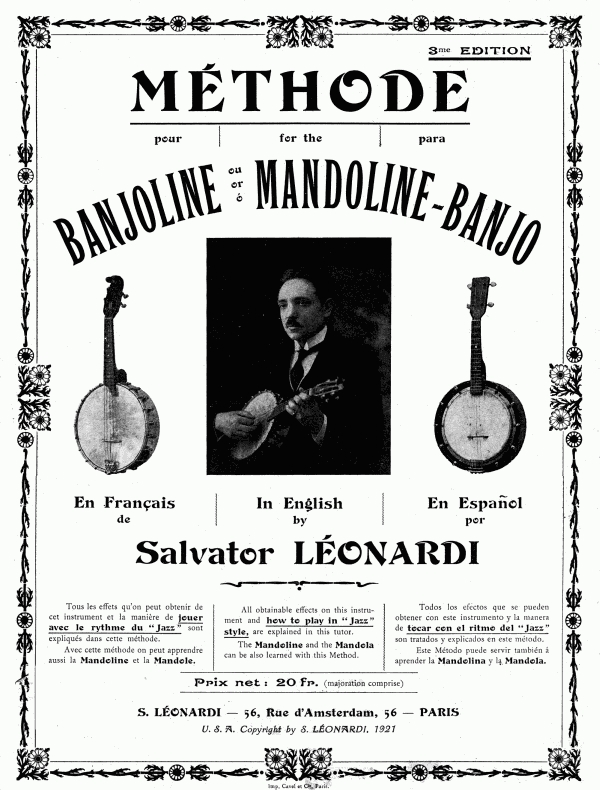Die Mandolinenschule von W. J. Fletcher (1896)
W. J. Fletcher Jun. A. M. G. V. L.
Fletcher’s Standard Mandoline Tutor
Containing a comprehensive system of learning the mandoline from the elementary to the most advanced stages
F. Pitman Hart & Co. Ltd. 20 & 21, Paternoster Row, London
Diese Schule habe ich aus England bei ebay ersteigert. Ich finde diese Schule ausgesprochen gut.
Was diese Schule auszeichnet ist zum einen die exakte Bezeichnung der Anschlagsarten. Ich habe zwei Beispiele von Stücken abgebildet, wo man das sehen kann. Fast durchgängig wird das Tremolo genau vorgeschrieben.
Auf 70 Seiten wird man bis hin zum Lagenspiel in der VII. Lage und zum Spielen von Doppelgriffen und Akkorden geführt. Am Ende der Schule findet man eine Reihe von Stücken mit Klavierbegleitung.
In der Schule wird häufig auf „Fletcher’s Standard progressive studies and duets for Mandoline“ hingewiesen – es wäre schön, wenn ich dieses Heft irgendwann finden könnte!
—–
This is an interesting method published in the UK in 1896. Especially the righ hand technique is very precisely noted. The method contains some duo-style arrangements of popular songs at the end. Unfortunately I have not found more information about Mr. Fletcher except the list of works below.
Fletcher lebte vom 8.10.1874 bis zum 16.10.1904, er wurde also nur 30 Jahre alt.
Eine ausführliche Biografie von William Fletcher habe ich in einer alten Zeitschrift gefunden. Alle Infos dazu gibt es in meinem Blog:
Die folgende Liste von Werken von William Fletcher habe ich bei Amazon gefunden, offensichtlich wurden diese Werke von William Jonas Fletcher schon einmal bei Amazon verkauft. Alle Werke sind zwischen 1887 und 1901 datiert.
List of works by Fletcher found on the amazon website – all works have been published between 1887 and 1901.
- 1. Eldora. Valse Espagnol. Mandoline Solo with Pianoforte Accompaniment and extra part for 2nd Mandoline by William Jonas Fletcher (Unknown Binding – 1899)
- 2. Continental Barn Dance. Mandoline Solo with Pianoforte Accompaniment and extra parts for 2nd Mandoline, Mandola and Guitar by William Jonas Fletcher (Unknown Binding – 1900)
- 3. Danse Romanese. Mandoline Solo with Pianoforte Accompaniment and extra parts for 2nd Mandoline and Mandola byWilliam Jonas Fletcher (Unknown Binding – 1901)
- 4. Intermezzo. Solo for Mandoline or Violin with Pianoforte Accompaniment by William Jonas Fletcher (Unknown Binding – 1899)
- 5. Grace and Beauty. Valse de Concert. Mandoline Solo with Pianoforte accompaniment, and extra part for 2nd Mandoline by William Jonas Fletcher (Unknown Binding – 1887)
- 6. Grand March in F. Mandoline Solo with Pianoforte Accompaniment and extra parts for 2nd Mandoline, Mandola and Guitar by William Jonas Fletcher (Unknown Binding – 1899)
- 7. Call to Arms. Quick March. Mandoline Solo with Pianoforte Accompaniment and extra parts for 2nd Mandoline, Mandola and Guitar by William Jonas Fletcher (Unknown Binding – 1901)
- 8. Jollity. Barn Dance. Mandoline Solo, with Pianoforte accompaniment and extra part for 2nd Mandoline by William Jonas Fletcher (Unknown Binding – 1895)
- 9. Our Nation. National Overture. Mandoline Solo with Pianoforte accompaniment, Arranged by W. J. Fletcher by William Jonas Fletcher (Unknown Binding – 1898)
- 10. Our Navy. Nautical Fantasia. Mandoline Solo with Pianoforte Accompaniment … Arranged by W. J. Fletcher, Junr by William Jonas Fletcher (Unknown Binding – 1899)
- 11. Scottish Festival. Mandoline Solo with Pianoforte Accompaniment … Arranged … by W. J. Fletcher, Junr by William Jonas Fletcher (Unknown Binding – 1901)
- 12. Serenade and Gipsy Dance. Mandoline Solo with Pianoforte accompaniment and extra part for 2nd Mandoline by William Jonas Fletcher (Unknown Binding – 1898)
- 13. Fletcher’s 60 Standard Intermediate & Advanced Exercises & Duets for the Mandoline … Composed and arranged by W. J. Fletcher,etc by William Jonas Fletcher (Unknown Binding – 1898)
- 14. Fletcher’s Standard Mandoline Tutor … Composed, compiled & arranged by W. J. Fletcher,etc by William Jonas Fletcher (Unknown Binding – 1896)
Downloads
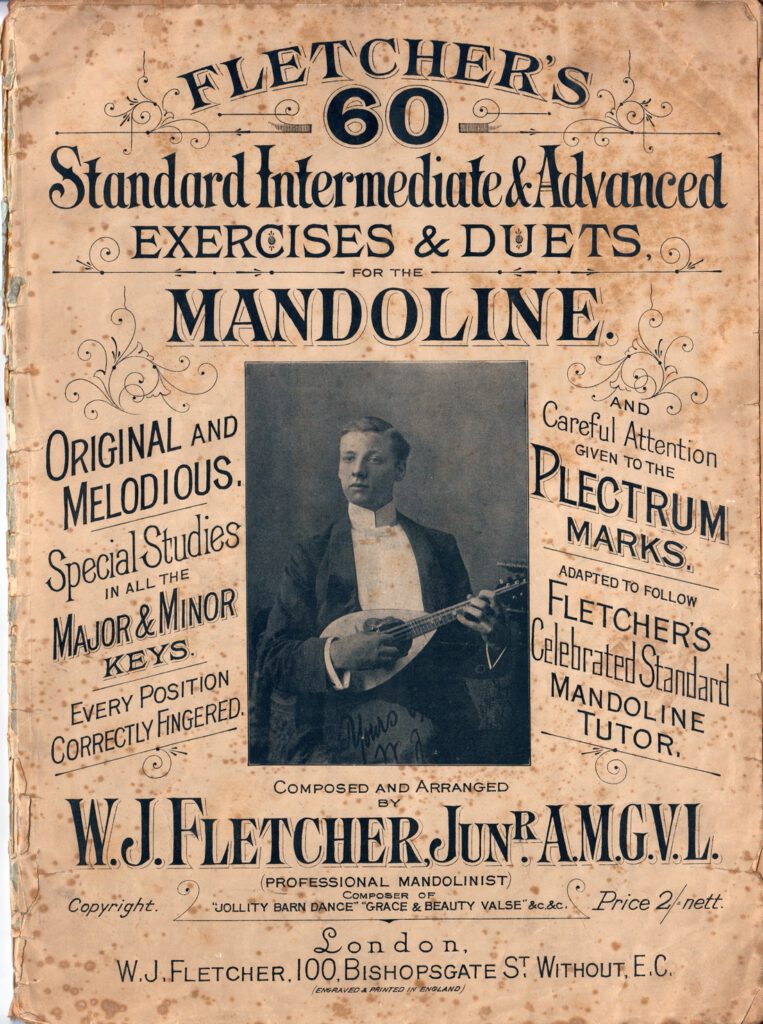
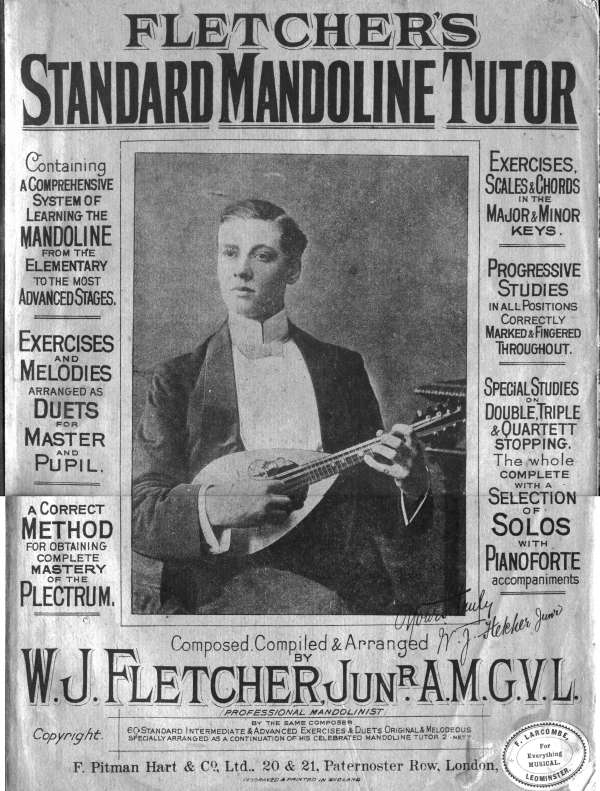
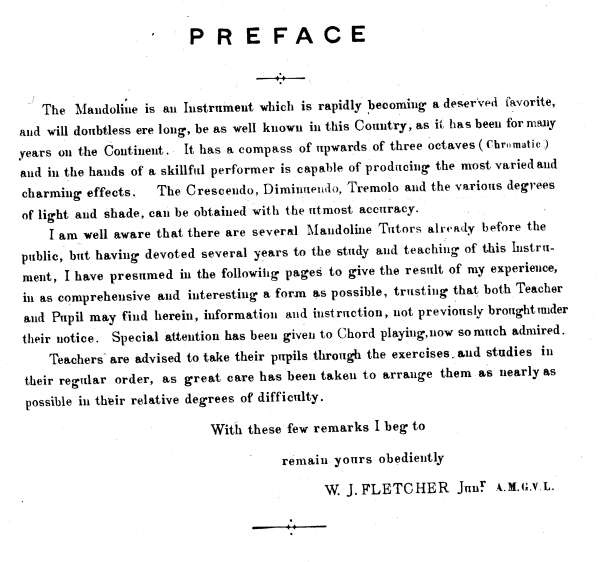
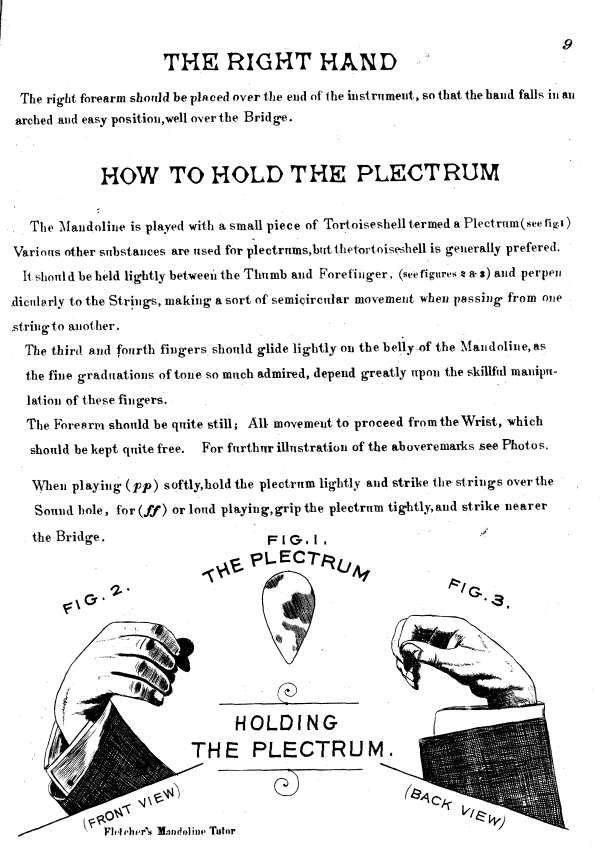
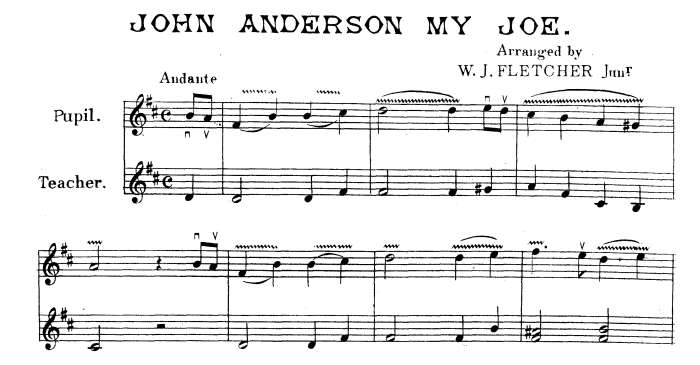
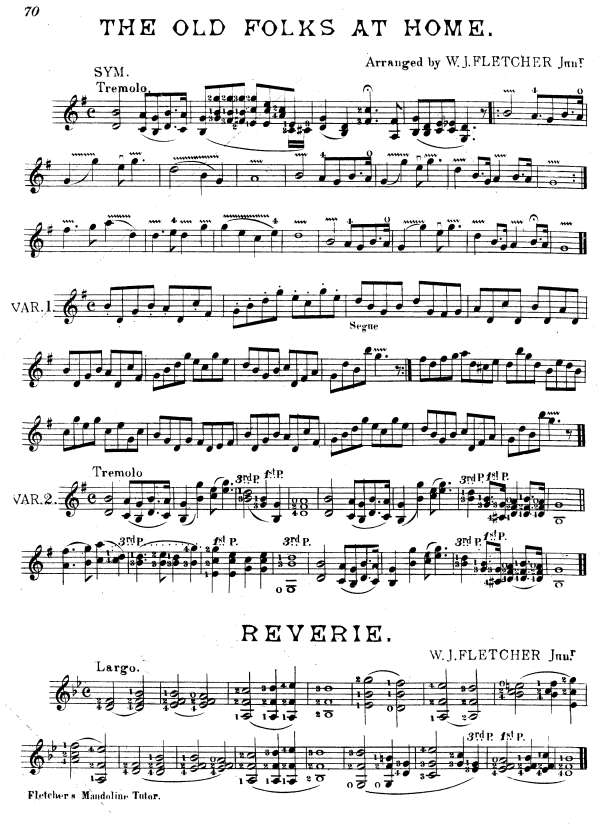
Biografie William J. Fletcher (8.10.1874 – 16.10.1904)
Das älteste und mit Abstand berühmteste Kind dieser begabten Familie wurde am 18. Oktober 1874 geboren. Seine frühen Jahre widmete er der Violine; tatsächlich erwarb er 1895 einen Ehrentitel am College of Violinists.
Dann wechselte er ganz plötzlich zur Mandoline. Zweifellos geschah dies, wie offiziell angegeben, teilweise aus geschäftlichen Gründen, aber es gab Gerüchte (die allerdings auch bloß Klatsch sein könnten), dass die ungerechte Vergabe der Goldmedaille in einem Wettbewerb viel mit dieser Abkehr von der Violine zu tun hatte.
In späteren Jahren behauptete er jedoch immer, dass praktische Kenntnisse der Violine einem Mandolinisten einen technischen Vorteil gegenüber Spielern ohne solche Erfahrung verschafften.
Er war groß, gutaussehend und von schlanker Statur. Obwohl er vor einem Konzert leicht nervös wurde, wenn etwas schiefging, liebten ihn alle im Orchester – und in der gesamten Welt der Saiteninstrumente – „Will“, wie er von allen genannt wurde.
Er heiratete am Weihnachtstag 1901, als er siebenundzwanzig Jahre alt war – seine Frau war Hannah Hilda Grandi, eine Mandolaspielerin im Orchester. Er war stets der Star-Solist bei den zahlreichen Konzerten des Orchesters und bekannt für seinen ausdrucksstarken Stil, sein bewundernswert klares Spiel in schnellen Passagen und sein gewölbtes Handgelenk. Tatsächlich galten die im November 1901 von der Edison Phonograph Co. veröffentlichten Aufnahmen seiner Soli als die bis dahin besten Mandolinenaufnahmen. Ich frage mich, ob noch welche davon erhalten sind?
Er soll der erste in England geborene Mandolinenspieler gewesen sein, der das verlängerte Griffbrett nutzte.
Abgesehen von seinen zahlreichen Kompositionen (und seiner soliden musikalischen Ausbildung, die er mit einer Begabung für Melodien verband) war sein Repertoire umfangreich und bestand hauptsächlich aus Bach und Beethoven – immer aus den Originalpartituren. Er trat häufig in der St. James’s Hall und bei ähnlichen Konzerten auf (zusammen mit Cammeyer, Farland und Obregon), und seine brillante Karriere ließ noch größere Triumphe erwarten, als die Welt der Saiteninstrumente am Sonntag, dem 16. Oktober 1904, von seinem Tod durch Lungentuberkulose erschüttert wurde.
Biografie William J. Fletcher (8.10.1874 – 16.10.1904)
MOST FAMOUS William Jonas Fletcher, Jr.
The eldest child and easily the most famous of this gifted family was born on October 18th, 1874. His early years were devoted to the violin; indeed, in 1895 he gained an Honours Degree from the College of Violinists.
Then quite suddenly he switched to the mandolin. No doubt, as was stated officially, this was partly for business reasons but it was roumored (though it might have merely been idle gossip) that the inequitable reward elsewhere of the gold medal in a contest had a good deal to do with this abandonment of the violin.
In after years, however, he always asserted that a working knowledge of the violin gave a mandolinist a technical advantage over players lacking such experience.
He was tall, good-looking and of slight build. Though apt to fuss a little when things went wrong prior to a concert, every one in the orchestra – and indeed throughout the fretted instrument world – loved “Will,” as he was known to all.
He was married on Christmas Day , 1901, when he was twenty-seven – his wife being Hannah Hilda Grandi, a mandola player in the orchestra. He was always the star soloist at the orchestra’s many concerts and was renowned for his expressive style, admirably clear picking in fast passages and his arched wrist. Indeed the records of his solos issued in November 1901 by the Edison Phonograph Co. were considered the most satisfactory mandolin recordings until then. I wonder if any can have survived ?
He was supposed to be the first English-born player of the mandolin to make use of the extended fingerboard.
Apart from his numerous compositions (and to a sound musical training he joined the gift of melody) his repertoire was extensive, consisting mainly of Bach and Beethoven – always from the original scores. He often appeared at the St. James’s Hall and similar concerts, (starring with Cammeyer, Farland and Obregon) and his career, brilliant as it was, presaged still greater triumphs when the world of fretted instruments was stunned to learn of his death from pulmonary tuberculosis on Sunday, 16th October 1904.
